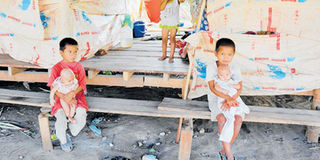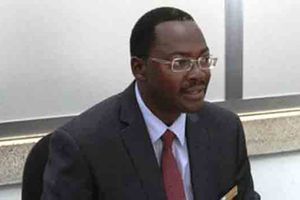Situation worsens in Myanmar despite Aung San Suu Kyi win

Children displaced by fighting in Kayin State in a makeshift shelter. PHOTO | IRIN
What you need to know:
- While expectations were high, Aung San Suu Kyi actually has limited influence over security matters. A military-drafted constitution reserves a quarter of parliamentary seats for serving officers and puts key ministries in military hands.
Many hoped that Aung San Suu Kyi’s electoral triumph would revive peace negotiations in Myanmar. The talks were fraught with distrust between the ethnic armed groups and the government, which was led by a party mainly comprised of former officers of the military that had ruled Myanmar for 49 years.
While expectations were high, Aung San Suu Kyi actually has limited influence over security matters. A military-drafted constitution reserves a quarter of parliamentary seats for serving officers and puts key ministries in military hands.
The constitution allows no civilian oversight for military operations, which means that Aung San Suu Kyi’s government does not have control over the military offensives in Myanmar’s northern Kachin and Shan states, or western Rakhine State.
What Aung San Suu Kyi does have is a lot of political capital, and she has been criticized for failing to expend some of it to stand up to the generals. As horrific reports of atrocities committed against Rohingya civilians emerged, her government’s response has been outright denial in defence of the military. To the dismay of some ethnic leaders, she has not condemned the military’s intensifying offensives in the north. Instead, she implored them to sign the NCA.
“I want to request of national ethnic groups who have not signed yet the cease fire treaty to sign with bravery and self confidence,” Aung San Suu Kyi said in a February 12 speech.
Almost a year after the NLD took power, the picture is grim. Fighting has gotten worse, and the government was forced to call off the next round of peace talks scheduled for 28 February. As the security situation has declined, so has access to those affected, with humanitarian groups saying the government is preventing them from bringing aid to displaced people.
The situation is so bad that the UN’s special rapporteur on human rights in Myanmar, Yanghee Lee, recently told IRIN that she would call for a “special session” at next month’s Human Rights Council meeting in Geneva. At the moment, she is scheduled to present her report on March 13, which will be followed by a two-and-a-half hour discussion. “That’s just not enough,” she said.
Lee mentioned in particular the recent assassination of Ko Ni, a respected legal advisor to the NLD and a prominent Muslim, the surge in fighting in northern Myanmar, and alleged abuses of ethnic Rohingya during military counter-insurgency operations in western Rakhine State.
Myanmar government spokesman Zaw Htay did not answer phone calls to respond to IRIN’s questions about the deteriorating situation.
The UN says about 218,000 people are displaced inside Myanmar, mostly in temporary camps in Kachin, Shan and Rakhine states. Many of them fled after ceasefires broke down in Shan and Kachin in 2011, and when mobs of nationalist Buddhists chased minority Rohingya Muslims from their homes in 2012.
Another 100,000 people or so more recently fled their homes. They include people like Naw Tin Swe in Kayin State, as well as thousands more in Shan and Kachin who have escaped clashes between ethnic armies and government forces. But the vast majority are Rohingya and most of them escaped over the border to Bangladesh.
More than 73,000 Rohingya have arrived in Bangladesh since the military launched operations in October in Maungdaw, a border township, and the UN estimates that another 24,000 are internally displaced. Amid reports of atrocities committed by the military against Rohingya civilians in Maungdaw, the government refused access to media as well as aid agencies.
aThe World Food Programme reported that it has recently been allowed to distribute some relief items, but restrictions remain in place in Rakhine, as well as other regions in the north and east.
The writer filed this article for IRIN from Myaing Gyi Ngu, Myammar




